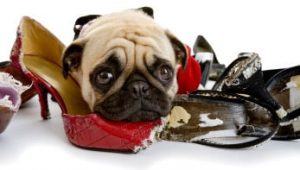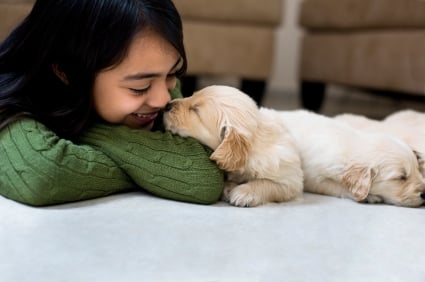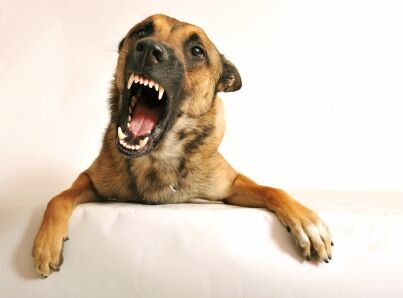Karen
Arnoff, dog behavior specialist with Cleveland Dog Training Classes warns about the “unexpected bite”
and what dog obedience training to do to prevent them.
By nature, dogs routinely use their mouths for sucking, chewing, exploring, carrying, playing, defending themselves, etc. They rely heavily on the use of their mouth and don’t know they shouldn’t use it to bite people. Most people hope that their adult dogs will have developed good habits regarding mouthing and biting.
But hoping isn’t enough! Dog obedience training requires that owners must take responsibility for teaching their dogs how and when to use their mouths appropriately. They must also learn to recognize the early warning signs of a potential bite. They need to take action to prevent THE UNEXPECTED BITE.
Innate drives of dogs
and how they use their mouths
Dogs may bite either intentionally or unintentionally. When dogs bite humans or another animal, they are in one or more of their three drives:
Why dogs bite:
- dominance
- possessiveness
- protectiveness
- maternal instinct
- predatory reflex
- fear
- redirected anger or frustration.
Dog bite warning signs:
Owners see, but may
fail to be concerned about signs of defensiveness when their dog
- freezes,
- cowers, backs
- runs away
- growls, snarls (showing teeth)
- snaps
- bristles (hackles up)
- becomes agitated
- paces nervously or intermittently crouches as if
about to attack
Because there is no bite when one or more of these signs are present, an owner may fail to recognize them as warnings. There may not be a bite, yet, because the dog is being introvertedly defensive or his threshold of tolerance to that particular situation is greater than his instinct to bite . . . for the moment.
The
“Unexpected Bite”
When a dog has a
history of not biting, owners tend to believe he will never bite. His threshold
of tolerance, however, may decreases as he:
- grows older
- becomes ill
- experiences pain
- reacts to medication
- matures socially
- reacts to a change in his environment
- has a combination of any of these events
and his response may then change to
the UNEXPECTED BITE.
Suppose a dog is
uncomfortable in hot weather, around children, sudden motion and high-pitched
noises. In the presence of only one of these triggers. he may not bite. If,
however, on a hot day, a little child is playing near him and then suddenly
darts through the sprinkler spray, and squeals with excitement, the dog’s
stress level may immediately increase–and then he might react with —THE
UNEXPECTED BITE. Preventive dog training
is required.
Or maybe a dog
has a low threshold of tolerance to pain, fears being cornered and is also defensive
about being grabbed. His defensive reactions could escalate quickly if, on the
same day he gets a shot from the vet and he is hugged tightly (cornered and
grabbed), once again there might be — THE UNEXPECTED BITE. Preventive dog training is a must.
These examples illustrate that it is not necessarily each individual stimulus that produces a bite. It can be caused by a complex of several stimuli. In both examples, the owner may be shocked, thinking, “he never bit anyone before” or “he’s never showed any signs that he would bite.” There is never a bite before the first bite without the ignored or unrecognized warning signs. Owners must learn that the signs of defensiveness are potentially serious and that preventive dog training is required in order to be more assured that the first bite never happens.
Anti-aggressiveness training
Responsible dog
owners will try to make sure their dogs don’t bite. Cleveland
Dog Training Classes helps owners learn how to recognize signs of dog
aggression and how to instigate dog training that teaches your dog not to be
aggressive. A major part of this for you,
the dog owner, to establish leadership (not domination) and proactively build
your dog’s confidence and reduce defensiveness around domestic stimuli.
Ideally, anti-aggressiveness training would be routine for all dog owners.
When to seek help
If a dog shows any defensive
behavior or overt aggression, a diagnostic session should be done by a qualified
dog behaviorist as soon as possible to determine:
·
the dog’s genetic predisposition
·
the contributing environmental factors
·
any physical factors that are contributing to
the defensiveness
·
which drive the dog was in (Treatment is
different for each drive,)
If a dog has already bitten, too many dog trainers or other dog professionals recommend euthanasia or re-homing. But these may not be the only solutions. With competent dog behavior counseling, many dogs that have bitten can be and have been retrained to use their mouths appropriately in a domestic setting.
Working toward a happy ending
For all dogs, prevention, of course,
is the best policy. However, when there
is an unexpected bite there is hope.
With an accurate diagnosis, and a
comprehensive treatment program including: humans establishing a kind, superior
and trusting relationship with their dog;
- teaching their dog self-control (rather than
stopping at just controlling their dog;
- creating associations whereby their dog views
all potentially defense-producing situations as positive and non-threatening
many dogs may be able to stay with their families. And dog owners will greatly reduce the possibility of their loved ones, or anyone, becoming a victim of THE UNEXPECTED BITE.
Karen’s knowledge, experience, use of her five-step model (See The Arnoff Model) and 30 years of client successes is why you’ll succeed with Cleveland Dog Training Classes (formerly the Dog-Owner Connection).
For more information or to make an appointment, call Cleveland Dog Training Classes at 440-349-5022.
©1995. Karen Arnoff. Revised ©2018





